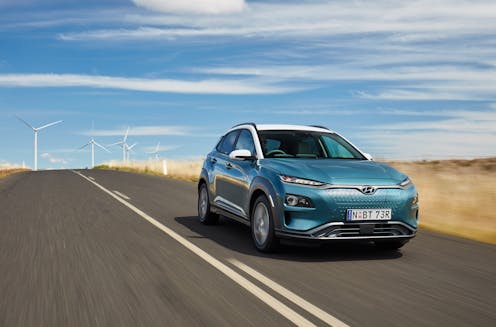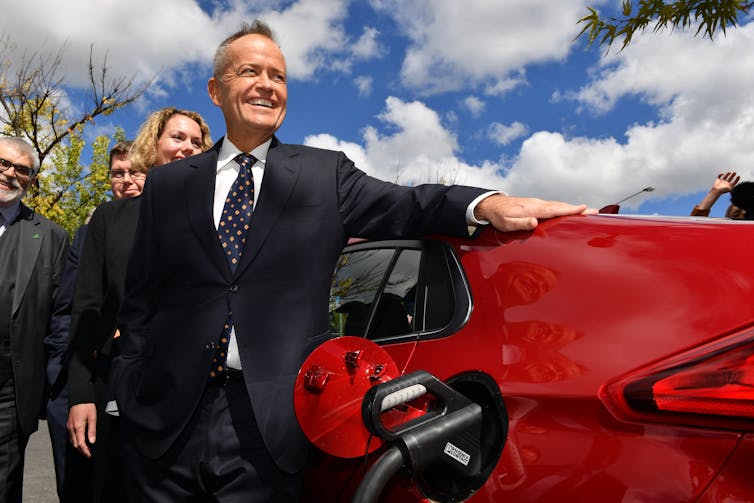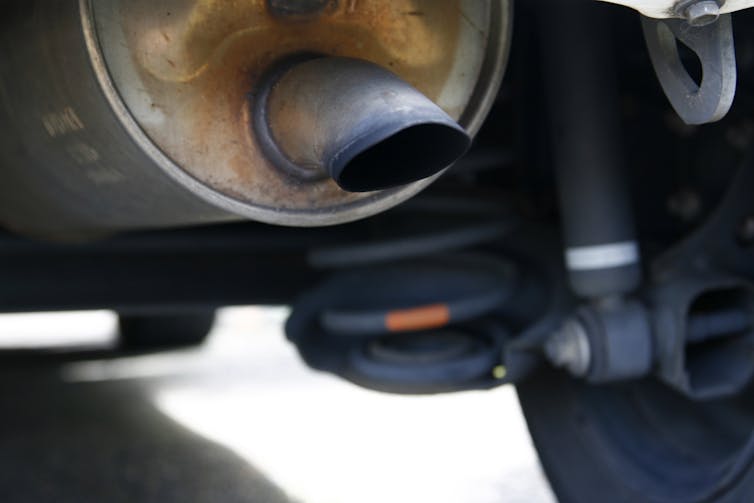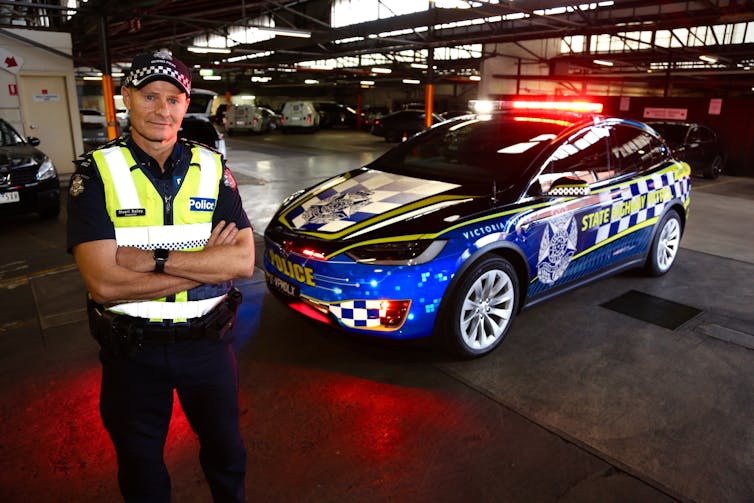 Evidence shows electric vehicles have significant economic, social and health benefits.
Evidence shows electric vehicles have significant economic, social and health benefits.Despite the overwhelming evidence that electric vehicle technology can deliver significant economic, environmental and health benefits, misinformation continues to muddy the public debate in Australia.
An article in The Australian recently claimed that on the east coast electric vehicles are responsible for more carbon dioxide emissions than their petrol counterparts.
The findings were largely attributed to Australia’s reliance on coal-fired power to charge electric vehicles. The report on which the article was based has not been publicly released, making it difficult to examine the claim.
So instead, let’s review the available evidence.
Read more: Here's why electric cars have plenty of grunt, oomph and torque
First, let’s get the maths right
Vehicles create two types of emissions: greenhouse gases and noxious air pollution.
Petrol and diesel vehicles produce the majority of emissions when they are being driven. These are known as “tank-to-wheel” or exhaust emissions, and contribute to both climate change and poor air quality.
 Then-Labor leader Bill Shorten at an event to announce Labor’s electric vehicle policy ahead of the May 2018 federal election.AAP
Then-Labor leader Bill Shorten at an event to announce Labor’s electric vehicle policy ahead of the May 2018 federal election.AAPTraditional vehicles also generate emissions through the production and distribution of their fuel, known as “well-to-tank” or upstream emissions.
To comprehensively measure a vehicle’s total emissions, we combine upstream and exhaust emissions to obtain “well-to-wheel” emissions, otherwise known as the fuel lifecycle emissions.
Read more: New Zealand poised to introduce clean car standards and incentives to cut emissions
How electric vehicles stack up
Battery electric vehicles have no exhaust emissions. Their emissions are primarily determined by the upstream emissions: that is, from the production and distribution of the energy used to charge them.
 A parking spot allocated to electric vehicles.AAP
A parking spot allocated to electric vehicles.AAPIn a paper I co-authored late last year, we estimated that the typical Australian petrol vehicle generated 355 grams of CO₂-equivalent per kilometre in real-world fuel life cycle emissions.
By comparison, a typical electric vehicle charged using the average Australian electricity grid mix generated about 40% fewer emissions, at 213 grams of CO₂-equivalent per kilometre.
Even with dirty energy, electric cars are greener
Electric vehicle emissions vary depending on how dirty the region’s electricity is. By applying the 2019 National Greenhouse Accounts Factors to the same methodology used in our journal paper, electric vehicle emissions in each of Australia’s electricity grids were calculated (see Table 1, click to zoom).
 Table 1: Real-world fuel lifecycle emission estimates for battery electric vehicles, hydrogen fuel cell vehicles and petrol vehicles, calculated using 2019 Greenhouse Account Factors.Dr Jake Whitehead
Table 1: Real-world fuel lifecycle emission estimates for battery electric vehicles, hydrogen fuel cell vehicles and petrol vehicles, calculated using 2019 Greenhouse Account Factors.Dr Jake WhiteheadVictoria has the most emissions-intensive grid in Australia due to its reliance on brown coal. However, even in that state, the real-world fuel life cycle emissions of a typical electric vehicle would still be 20% lower than a typical petrol vehicle. In Tasmania, which is dominated by renewable energy, electric vehicle emissions would be 88% lower than a comparable petrol vehicle.
Read more: Why battery-powered vehicles stack up better than hydrogen
 Electric vehicles are less polluting than traditional cars, even in Victoria which is heavily reliant on brown coal to produce electricity.AAP
Electric vehicles are less polluting than traditional cars, even in Victoria which is heavily reliant on brown coal to produce electricity.AAPSize doesn’t matter
 Table 2: Fuel lifecycle emissions extracted from the Australian Government’s Green Vehicle Guide (GVG).*Dr Jake Whitehead
Table 2: Fuel lifecycle emissions extracted from the Australian Government’s Green Vehicle Guide (GVG).*Dr Jake Whitehead Table 3: Comparison between the relative differences in electric vs petrol vehicle fuel lifecycle emissions from the analysis Green Vehicle Guide emissions data (see part of sample in Table 2) and the real-world estimates from our journal article (see Table 1). The consistency in findings supports the robustness of these conclusions.Dr Jake Whitehead
Table 3: Comparison between the relative differences in electric vs petrol vehicle fuel lifecycle emissions from the analysis Green Vehicle Guide emissions data (see part of sample in Table 2) and the real-world estimates from our journal article (see Table 1). The consistency in findings supports the robustness of these conclusions.Dr Jake WhiteheadLet’s examine four different sized electric vehicles in Australia to see how their fuel lifecycle emissions compare to petrol vehicle equivalents (see Table 2, click to zoom).
Even when large electric cars are charged using Victoria’s grid, emissions are 6-7% lower than a petrol vehicle equivalent.
Using both real-world emissions estimates and Green Vehicle Guide data, the shift from petrol to electric vehicles is shown to deliver a reduction in emissions - no matter where vehicles are charged in Australia (see Table 3, click to zoom).
And of course emissions from electric vehicles will fall further as grid electricity continues to become cleaner.
Anyway, lots of electric cars don’t need the grid
There is clearly a strong relationship between ownership of both electric vehicles and zero-emission rooftop solar.
In 2018 we surveyed more than 150 electric vehicle owners in Australia (representing 2% of the national fleet). We found that 80% of vehicle charging occurred at home, with 73% of respondents owning rooftop solar systems (compared to an average of 21.6% of homes nationally)).
 Victoria Police Inspector Stuart Bailey with the first all-electric vehicle in its operational fleet.Victoria Police
Victoria Police Inspector Stuart Bailey with the first all-electric vehicle in its operational fleet.Victoria PoliceAdditionally, 22% of electric vehicle owners surveyed had stationary battery storage attached to their solar rooftop systems, with another 53% planning to install batteries in the near future.
Five more reasons to embrace electric vehicles:
Cost savings: Electric vehicles are 70-90% cheaper to operate, potentially saving households more than A$2,000 per year.
Economic opportunities: The Australian resources sector is well placed to capitalise on demand for minerals in batteries, such as lithium, and support the deployment of this technology globally using cheap, reliable and locally-produced energy.
Fuel security: Australia is heavily dependent on imported fuels and holds reserves far below the International Energy Agency’s obligated 90-day supply. So the more quickly we transition to electric vehicles, the more secure our transport system will be.
Read more: How electric cars can help save the grid
4) Grid support: Electric vehicles hold enormous potential to support our electricity grid. If Australia’s 14 million-odd cars were electric, the energy stored in their batteries could power the entire nation for at least 24 hours, while still meeting average driving needs.
 Vehicle emissions from petrol and diesel cars drives air pollution and associated illnesses such as asthma.AAP
Vehicle emissions from petrol and diesel cars drives air pollution and associated illnesses such as asthma.AAP5) Health benefits: Noxious emissions from traditional vehicles also take a massive toll on our health by contributing to rates of asthma and other chronic illnesses. Vehicle pollution causes an estimated 40% to 60% more premature deaths than road accident fatalities in Australia. Electric vehicles provide a pathway to avoid these deaths.
Even international bank BNP Paribas sees the writing on the wall. In advice to investors last month it outlined that thanks to electric vehicles, the economics of oil for transport was “in relentless and irreversible decline, with far-reaching implications for both policymakers and the oil majors.”
*Note: The Green Vehicle Guide figures in Table 2 are based on a 1997 drive cycle - the New European Drive Cycle or NEDC - which significantly underestimates real-world emissions and efficiency. As a result, Green Vehicle Guide values for all vehicles are lower than the real-world emissions estimates we published in our 2018 paper. Despite this, the relative difference in emissions between electric and petrol vehicles is largely consistent with our estimates - see Table 3 - and therefore these figures are still useful for comparing different vehicles.
Dr Jake Whitehead is a Tritium e-Mobility Research Fellow at the UQ Dow Centre for Sustainable Engineering Innovation at The University of Queensland, Research Fellow at UQ School of Civil Engineering, Secretariat of the Clean Transport Coalition, Member of the International Electric Vehicle Policy Council and Director of Transmobility Consulting.
Authors: Jake Whitehead, Research Fellow, The University of Queensland
Read more http://theconversation.com/clean-green-machines-the-truth-about-electric-vehicle-emissions-122619
| < Prev | Next > |
|---|








